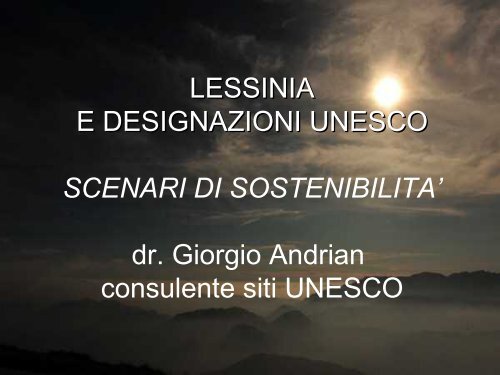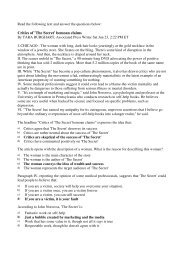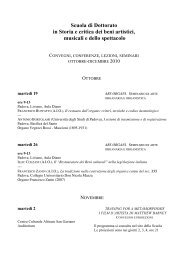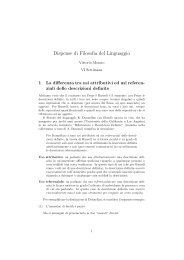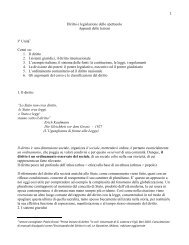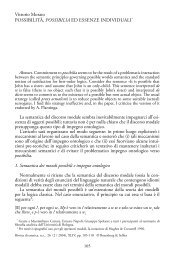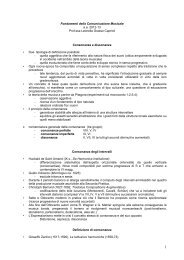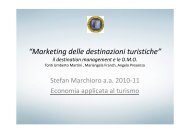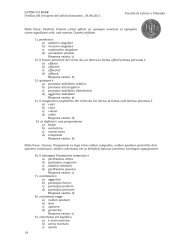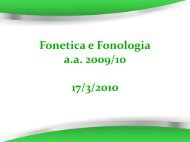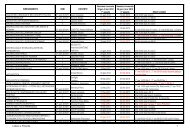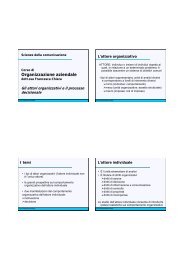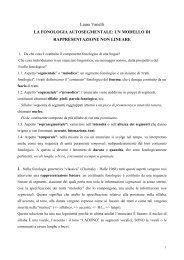dr. Giorgio Andrian consulente siti UNESCO - Lettere e Filosofia
dr. Giorgio Andrian consulente siti UNESCO - Lettere e Filosofia
dr. Giorgio Andrian consulente siti UNESCO - Lettere e Filosofia
Create successful ePaper yourself
Turn your PDF publications into a flip-book with our unique Google optimized e-Paper software.
LESSINIA<br />
E DESIGNAZIONI <strong>UNESCO</strong><br />
SCENARI DI SOSTENIBILITA’<br />
<strong>dr</strong>. <strong>Giorgio</strong> An<strong>dr</strong>ian<br />
<strong>consulente</strong> <strong>siti</strong> <strong>UNESCO</strong>
L’IRRESISTIBILE<br />
TENTAZIONE DELLA<br />
MEDAGLIA!
LA GOVERNANCE MULTILIVELLO<br />
SOVRA-NAZIONALE<br />
(REGIONALE)<br />
NAZIONALE<br />
LOCALE
GEOPARCHI<br />
“I Geoparchi Europei sono dei territori che includono al loro<br />
interno particolari patrimoni geologici e che sono dotati di una<br />
strategia di sviuppo territoriale sostenibile supportato da un<br />
programma Europeo di promozione dello sviluppo sostenibile” (<br />
www.geoparks.com)<br />
“I Geoparchi sono territori che promuovono il ‘geoturismo’ in<br />
cooperazione con gli abitanti del luogo; sono ‘territori sperimentali’<br />
all’interno di un network tematico”<br />
L’<strong>UNESCO</strong> (Divisione Scienza) supporta il concetto del Geoparco,<br />
il suo ruolo chiave nella diffusione scientifica e la Rete<br />
Internazionale dei Geoparchi
I GEOPARCHI IN EUROPA<br />
49 in 19 paesi<br />
IN ITALIA<br />
1. Madonie<br />
2. Parco del Beigua<br />
3. Parco Minerario della<br />
Sardegna<br />
4. Parco Naturale<br />
Adamello Brenta<br />
5. Parco Nazionale del<br />
Cilento e Vallo di<br />
Diano<br />
6. Parco delle Colline<br />
Metallifere<br />
Grossetane<br />
7. Alpi Apuane
PROTEZIONE<br />
SVILUPPO
936 <strong>siti</strong> in 153 Stati Membri<br />
(<strong>UNESCO</strong>, Settembre 2011)<br />
725 culturali 183 naturali and 28 misti
UN TREND IN CRESCITA COSTANTE<br />
WH Sites Desigantion Trends<br />
70<br />
Number of Sites<br />
60<br />
50<br />
40<br />
30<br />
20<br />
10<br />
0<br />
1972<br />
1979<br />
0<br />
12<br />
47<br />
28 27<br />
24<br />
31<br />
22<br />
30 29<br />
42<br />
27<br />
1981<br />
1983<br />
1985<br />
1987<br />
1989<br />
8<br />
16<br />
37<br />
33<br />
29 31<br />
22 20<br />
Designation's Year<br />
47<br />
30<br />
1991<br />
1993<br />
1995<br />
1997<br />
1999<br />
49<br />
63<br />
32<br />
9<br />
2001<br />
2003<br />
2005<br />
2007<br />
35 33<br />
25<br />
23<br />
19<br />
Total Sites<br />
Nature<br />
Culture<br />
Mixed<br />
Linear Total Trend<br />
y = 0.3306x + 23.097
DISTRIBUZIONE PER REGIONI NEL MONDO<br />
Number of WH Sites per Region<br />
35<br />
46<br />
4<br />
57<br />
35<br />
39<br />
119<br />
59<br />
379<br />
81<br />
Nuture Sites<br />
Culture Sites<br />
Mixed Sites<br />
3<br />
9<br />
1<br />
10<br />
3<br />
AFR APA ARB EUR LAC<br />
Region<br />
Source: The World Heritage Center (2007); AFR: Africa, APA: Asia and the Pacific, ARB: Tha Arab States, EUR: Europe and North<br />
America, LAC: Latin America and the Caribbean
ITALIA,<br />
CAMPIONE<br />
DEL MONDO!<br />
47 SITI<br />
(44 CLT e<br />
3 NAT)
SITO EOLIE EOLIE SERIALE DELLE<br />
ISOLE EOLIE<br />
iscrizione 2000<br />
Criterio viii
I 9 SITI SERIALI DELLE DOLOMITI<br />
iscrizione 2009<br />
criteri vii e viii
SITO TRANSFRONTALIERO<br />
(ITALIA E SVIZZERA) MONTE S.GIORGIO<br />
prima iscrizione (parte svizzera) 2003<br />
estensione 2010<br />
criterio viii
RETE MONDIALE DELLE RISERVE DELLA BIOSFERA<br />
580 RBs in 114 paesi (Giugno 2011)
UN TREND IN CRESCITA COSTANTE<br />
Increase in the Total Number of Biosphere Reserves<br />
80<br />
600<br />
70<br />
500<br />
60<br />
number of new designations<br />
50<br />
40<br />
30<br />
20<br />
400<br />
300<br />
200<br />
number of total designations<br />
10<br />
100<br />
0<br />
1976 1978 1980 1982 1984 1986 1988 1990 1992 1994 1996 1998 2000 2002 2004 2006<br />
year<br />
0<br />
designation/year<br />
BRs total<br />
Source: Bertzky, M. (2007), Schliep R, M. Bertzky, N. Fritz-Vietta, S. Stoll-Kleemann, “The Cinderella Syn<strong>dr</strong>ome - Assessing Governance of Biosphere<br />
Reserves through Case Studies from the Czech Republic, Hungary, Poland, Madagascar, and Mexico”, Humboldt-Universität zu Berlin, Germany, 2007
FUNZIONI<br />
Conservazione in situ<br />
diversità genetica e<br />
habitat naturali e seminaturali<br />
Conservazione<br />
Sviluppo<br />
sostenibile<br />
Sviluppo sostenibile aree<br />
dimostrative di pratiche di<br />
sostenibilià<br />
Supporto<br />
logistico<br />
Supporto logistico a progetti di ricerca, monitoraggio<br />
ed educazione ambientale
ZONIZZAZIONE<br />
◗ Core area(s)<br />
T<br />
R Stazioni di ricerca e<br />
sperimentazione<br />
◗ Buffer zone(s)<br />
◗ Tran<strong>siti</strong>on area(s)<br />
T<br />
E<br />
R<br />
M<br />
R<br />
M Monitoraggio<br />
E Educazione/training<br />
T Turismo
L’IMPORTANZA DELLE ZONE DI TRANSIZIONE<br />
Percentage of areas in core, buffer and tran<strong>siti</strong>on zones<br />
among the 187 third generation (post-Seville) biosphere<br />
reserves<br />
Core<br />
11%<br />
Tran<strong>siti</strong>on<br />
57%<br />
Buffer<br />
32%<br />
Core<br />
Buffer<br />
Tran<strong>siti</strong>on<br />
Data provided by Ana Persic, <strong>UNESCO</strong>-MAB (2007) edited by KH Gau<strong>dr</strong>y
CRITERI<br />
1. includere nel sito candidato un mosaico di sistemi ecologici<br />
rappresentativi delle principali regioni biogeografiche,<br />
includendo anche un gradiente coerente di attività antropiche<br />
2. essere rilevante ai fini della protezione della biodiversità<br />
3. essere in grado di dimostrare degli approcci allo sviluppo<br />
sostenibile rilevanti a scala regionale<br />
4. avere una dimensione appropriata per poter ottemperare alle 3<br />
funzioni delle Riserve della Biosfera<br />
5. includere le tre funzioni principali, attraverso un’appropriata<br />
zonazione;
CRITERI (continuazione)<br />
6. essere caratterizzato da forme di governance che garantiscano<br />
il coinvolgimento e la partecipazione di un rappresentativo gruppo<br />
di inter alia ovvero soggetti di diritto pubblico, comunità locali,<br />
soggetti di diritto privato egualmente impegnati e coinvolti nella<br />
candidatura della Riserva della Biosfera<br />
7. essere caratterizzata dalla individuazione preliminare di:<br />
(a) meccanismi specifici per la gestione delle attività presenti nella<br />
zona buffer;<br />
(b) una chiara policy e un piano di gestione per l’intera area da<br />
designare a Riserva della Biosfera;<br />
(c) un’autorità designata o un meccanismo identificato per la<br />
gestione del suddetto piano;<br />
(d) un programma per la ricerca, il monitoraggio, l’educazione e la<br />
formazione da svolgersi nell’ambito della Riserva della Biosfera
DISTRIBUZIONE DEI SITI <strong>UNESCO</strong> NELLE REGIONI ITALIANE
IL PIANO DI GESTIONE <strong>UNESCO</strong>: UN PIANO DI COORDINAMENTO<br />
Public Works<br />
Plan<br />
Master Plan<br />
Site<br />
Management<br />
Plan<br />
Touristic<br />
Plan<br />
Financial<br />
Report<br />
Management<br />
Control<br />
System
FERRARA E IL DELTA DEL PO
WH e MaB<br />
QUADRO DI CONFRONTO<br />
documenti chiave<br />
WH<br />
Convenzione del Patrimonio<br />
Mondiale (1972) e Linee Guida<br />
Operative<br />
MAB<br />
Qua<strong>dr</strong>o Statutario, Strategia di<br />
Siviglia (1995) Piano di Azione<br />
di Ma<strong>dr</strong>id (2008)<br />
segretariato<br />
e organi principali<br />
preparazione<br />
candidatura<br />
revisione dei piani di<br />
gestione<br />
organi ufficiali di<br />
consulenza<br />
Centro del Patrimonio Mondiale<br />
(<strong>UNESCO</strong> Parigi)<br />
Comitato del Patrimonio<br />
Mondiale (26 Stati Membri)<br />
Elevata rigorisità (OUV)<br />
1 anno nella Tentative List<br />
elevata numerosià <strong>siti</strong><br />
Rapoprto Periodico degli Sati<br />
Membri (ogni 10 anni)<br />
ICOMOS<br />
IUCN<br />
ICCROM<br />
Segretariato MAB<br />
(<strong>UNESCO</strong> Parigi)<br />
Consiglio di Coordinamento<br />
Internazionale (ICC)<br />
complessa gestione di territori<br />
ampi<br />
Procedura semplificaa<br />
Revisone periodica (ogni 10<br />
anni)<br />
Non previsti
non c’è un’ultima parola,<br />
ma un costante divenire e riattivarsi<br />
(Thrifth)
AL LAVORO!


